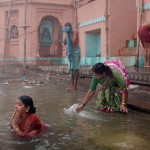 Earlier this year I wrote about a new product called uMed. The device, which costs just $25, aims to offer a range of chemical and biochemical tests using a number of commercially available test strips and electrodes. This analysis then produces a range of outputs, which are sent via a cable attached to the headphone jack of a standard mobile phone. The data is sent via the voice channel of any mobile network, so there is not even the need of a data connection.
Earlier this year I wrote about a new product called uMed. The device, which costs just $25, aims to offer a range of chemical and biochemical tests using a number of commercially available test strips and electrodes. This analysis then produces a range of outputs, which are sent via a cable attached to the headphone jack of a standard mobile phone. The data is sent via the voice channel of any mobile network, so there is not even the need of a data connection.
One of the applications for it is to test for the safety of drinking water. Such an application becomes incredibly powerful when the results become aggregated and policy makers can begin to get a great idea of which water sources are clean, and which are not.
A recent study set to do just that. The research, conducted across three continents utilized super cheap testing kits and the simple mobile phones that are common throughout India to try and draw up a more accurate map of water supplies across rural India.
The initial study explored eight villages, with the aim that this will be rolled out on a more widespread scale next year. If it proves successful in India, then hopefully it will be deployed in other nations, and indeed for other uses.
“It would be impossible to pay somebody to go out and take all these samples, bring them back to a central lab and process them under controlled conditions,” the researchers say. “But we think there are a lot of promising methods for testing water safety that don’t involve expensive laboratories and highly-trained personnel.”
The technique used is a simple one. The testing kits, which include a test tube that contains a material that changes colour when bacteria is present, are distributed throughout each village. Villages then fill the tubes with water, be that from a tap or from storage containers in their homes. The tubes are then incubated overnight, with the results from the test sent via a text message sent over their mobile phone to specific numbers depending upon the result.
These results are received by a smartphone that analyzes the collective responses and provides a reading of water quality for each village.
“The key to this is aggregating many, many samples that each indicate the presence or absence of bacteria,” the researchers continue. “Individually, the tests don’t tell us much, but if you take a thousand of them, you can compute an estimate of what the microbial counts will be in a typical drinking water source.”
The small initial sample has already received results from 1,800 villagers, with the data communicated to villagers via follow up visits. This was often accompanied with explanations and interpretations of the results by the villagers themselves, with solutions often suggested alongside them.
For instance, it often emerged that water from the tap was higher quality than that which was stored in the home, with possible reasons including a failure to cover the containers and the use of contaminated bowls to scoop the water out.
As the whole process was pretty straightforward, the team hope that it will scale up relatively easily, offering a real opportunity to improve the lives of millions of rural citizens throughout the world.
Great! This is a creative article, there are a lot of new ideas. It gives me new inspirations.
Great example, wonderful to see things like this.
Interesting and informative post, thanks.
Very creative way to collect significant amounts of data without spending tons of money.
That is if the crowd cooperate…